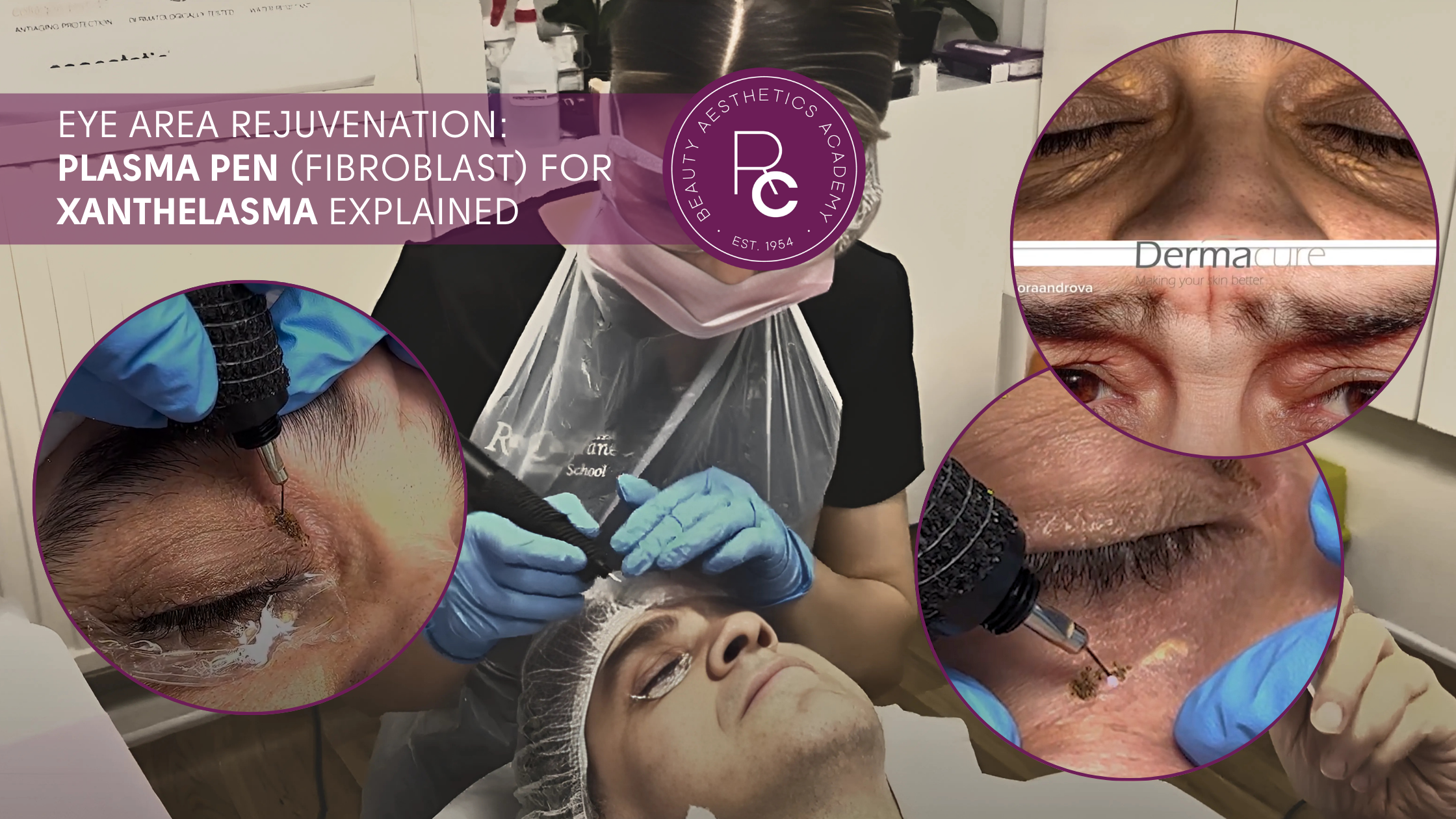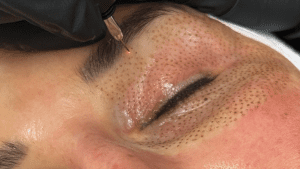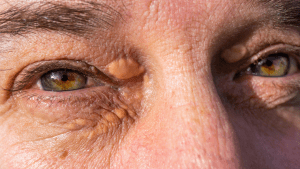
When it comes to the eye area, no other part of the face stirs as much anxiety or excitement among aesthetic practitioners. The eyelids, under-eyes, and surrounding skin are delicate and revealing, both of age and fatigue. Clients are naturally eager for rejuvenation here. Yet, as all experienced professionals know, the very features that make the eyes so expressive also make this area the most difficult, and yes, sometimes the most lucrative, to treat effectively and safely.
What is Plasma Pen (fibroblast) eye rejuvenation?
Let’s talk about plasma pen (fibroblast) eye rejuvenation. You might have heard it called non-surgical blepharoplasty, though the technology and theory behind it goes beyond a simple label. The plasma pen uses ionised gas, creating a tiny arc that contracts and tightens loose skin. When done skillfully, it can dramatically soften fine lines, lift sagging eyelids, and even address stubborn concerns like xanthelasma—the yellow cholesterol deposits that sometimes form along the inner eyelids.
What concerns can Plasma pen treat around the eye area?
Plasma pen eye rejuvenation can address a range of concerns, including:
- Fine lines and wrinkles (crow’s feet)
- Crepey or sagging upper and lower eyelid skin
- Xanthelasma (yellowish cholesterol or fat deposits around the eyes)
- Mild to moderate skin laxity
However, it is not suitable for everyone, especially those with very dark skin (higher Fitzpatrick types) or certain health conditions.

What is Xanthelasma?
Xanthelasma is a condition where soft, yellowish bumps or plaques appear on or around the eyelids. These patches are actually deposits of cholesterol or other fats beneath the surface of the skin.
They’re not harmful or contagious, but they can be distressing for clients because they’re so noticeable, especially on the delicate skin near the eyes. While xanthelasma doesn’t usually cause pain, its presence can affect self-confidence, and clients often seek removal for cosmetic reasons.
Some people develop xanthelasma even if their cholesterol levels are normal, but in many cases, these deposits are linked to raised blood lipids or metabolic factors. It’s always good practice to recommend that clients who present with xanthelasma check in with their GP or a healthcare provider about their overall cholesterol and heart health, in addition to exploring aesthetic treatment.

Why is the eye area so challenging, and so lucrative for plasma pen treatments?
The skin around the eye is the thinnest on the body and extremely sensitive. This creates significant risk:
- High risk of swelling, hyperpigmentation, or scarring if the wrong settings or poor technique are used.
- Patients are highly motivated for results, so demand for a safe, effective, non-surgical option is strong.
When performed correctly, outcomes can be dramatic, making plasma pen for eye rejuvenation one of the most rewarding (and profitable) treatments in advanced aesthetics.
Step-by-step guide: Plasma Pen treatment for the eye area
Watch Eleonora Androva, our Director of Education, as she demonstrates plasma pen eye area rejuvenation for xanthelasma. We invited Eleonora to share her expert tips and personal insights, drawing on her extensive experience both as a leading advanced aesthetics educator and as the founder of a luxury clinic.
As a respected beauty YouTuber with a loyal following, Eleonora brings a unique blend of clinical expertise and real-world teaching, making her the ideal mentor for practitioners aiming to master the plasma pen treatment with confidence and care.
Watch the video below and read our step by step guide on how to treat xanthelasma around the eyes with Plasma Pen.
1. Preparation:
Cleanse the area thoroughly to remove all dirt and bacteria. Apply a topical anaesthetic and allow it to take effect for 20–30 minutes.
2. Assessment:
Assess the client’s skin type. “Darker skin types need extra care to avoid pigmentation issues,” says Eleonora. In some cases, melanin-suppressing cream is recommended after treatment.
3. Performing the procedure:
Set the plasma pen device to an appropriate power. Work carefully and precisely on targeted areas only. In the case of xanthelasma, gently burn off the deposit in a controlled fashion. For wrinkles or laxity, treat across the area to stimulate tightening.
4. Immediate aftercare:
Apply a secondary anaesthetic or healing cream. Advise the client that some swelling and a “crust” or scab is normal.
5. Home care advice:
No picking at the area. Keep it dry and avoid sun exposure. Recommend a gentle healing cream and warn clients to avoid touching or irritating the treated skin.
Interested in Plasma Pen training at Ray Cochrane Beauty Aesthetics Academy
If you’re serious about offering plasma pen (fibroblast) treatments safely and expertly, especially around the delicate, high-risk eye area, it’s crucial to invest in accredited training.
At Ray Cochrane Beauty Aesthetics Academy, we offer the VTCT Level 4 Plasma Pen course, designed specifically for beauty professionals who want to master this advanced skill with confidence and safety.
Stay tuned to learn more about what the plasma pen can do…
This is just the first part of our special series on plasma pen treatments. We’ll be sharing more expert insights, real case studies, and practical guidance to help you get the most out of this powerful, innovative device. Watch this space!
FAQ’s
➤ What’s your biggest advice for those considering Plasma Pen under the eyes?
A: “Never rush. The eye area is risky, and safety can’t be compromised. Always get specialist training, follow sterile practice, and educate your client about realistic results and aftercare.”
➤ What makes this treatment so appealing to beauty pros?
A: “People are seeking visible results without surgery. When you combine skill with safety, this can be one of the most lucrative and satisfying services in advanced aesthetics.”
➤ How many sessions are usually needed?
A: “In many cases, just one session offers up to 80% improvement, especially for xanthelasma. However, 2–3 sessions may be necessary for optimal results, depending on the severity and skin response’’
➤ What are the risks and how can they be minimised?
- Primary risks: Swelling, hyperpigmentation (especially in darker skin), infection, scarring.
- How to minimise: Use a fully-trained professional, tailor the settings and aftercare to the individual, and always respect healing time.
➤ What should clients avoid after Plasma Pen treatment to the eye area?
- No touching, picking, or rubbing the area
- No water or makeup until crusts fall off naturally
- No sun exposure; use SPF when healing is complete
- Avoid harsh products and heat (e.g. saunas) for at least 48 hours
➤ Is Plasma Pen treatment around the eye permanent?
”Results can be long-lasting, but not truly permanent, skin continues to age and lifestyle factors matter. For stubborn conditions like Xanthelasma, recurrence is possible, but usually not immediate.”
